Trouble from Below: Subterranean Army Ants Raid Nests of Endangered Amazon River Turtles
By Sean O'Donnell, PhD
June 28, 2021
East of the northern Ucayali River in Peru is a geologically subsiding basin crossed by winding rivers and extensive wetlands. Much of this topographically flat region is flooded for several months annually by seasonal heavy rains. In this basin is the privately owned and managed Tapiche Reserve, a protected area of about 6000 ha that spans the Tapiche River. The reserve “land” is mostly under water at least two meters deep during the flood season. When the waters retreat, sandy beaches on the Tapiche River edges are visited by females of three species of Amazon river turtles (genus Podocnemis). Like sea turtles, Amazon river turtles lay their eggs in nests dug into beach soils.
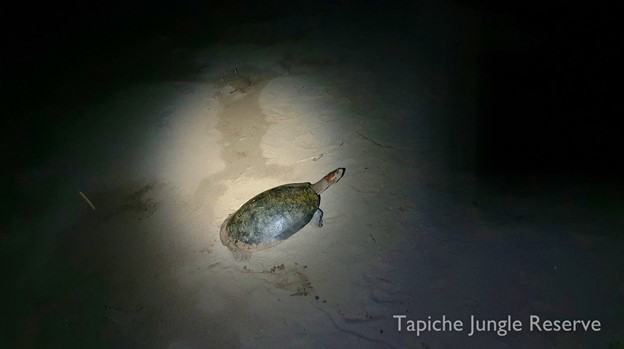 A female Amazon River Turtle (Podocnemis species) nesting on a Tapiche River beach.
A female Amazon River Turtle (Podocnemis species) nesting on a Tapiche River beach.
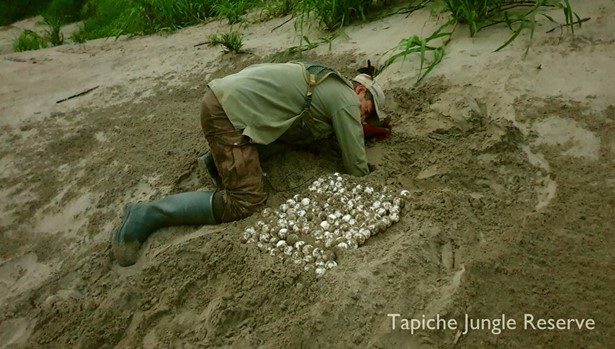 A researcher removing eggs from a Giant Amazon River Turtle (P. expansa) nest.
A researcher removing eggs from a Giant Amazon River Turtle (P. expansa) nest.
Turtle eggs are subject to heavy human poaching on the Tapiche River, so the Tapiche Reserve staff (co-authors Murilo Reis, Jana Reintjes and Deborah Chen) have run a river turtle rescue and head-start program annually since 2012. They collect eggs from the reserve’s beaches and rear them in a guarded hatchery built on a beach at the reserve lodge. Eggs are placed in artificial nests in the hatchery, dug to dimensions that match the natural turtle nests.
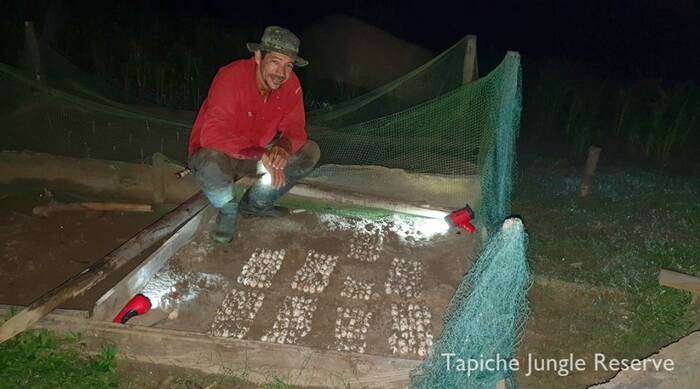 Preparing artificial nests for Amazon River Turtles in a hatchery at the Tapiche Reserve Lodge.
Preparing artificial nests for Amazon River Turtles in a hatchery at the Tapiche Reserve Lodge.
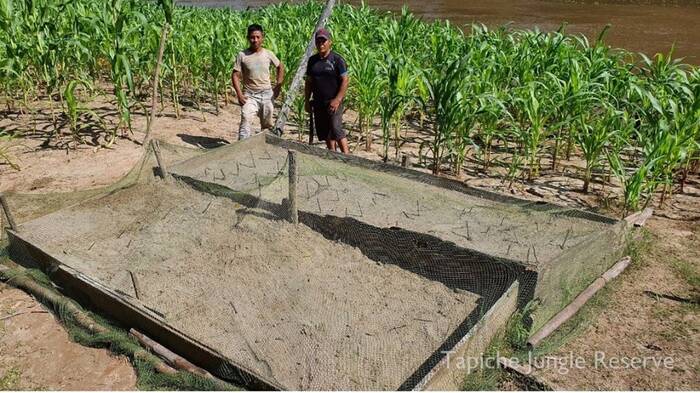 Completed turtle hatchery.
Completed turtle hatchery.
Turtle egg rescue efforts were especially successful in 2020. Over 9000 eggs were collected from 240 nests of three species of Amazon River Turtles, including the first nests of the critically endangered Giant Amazon River Turtle recorded in the area. Unfortunately, in fall 2020, the hatchery was attacked by subterranean army ants (Labidus coecus). The ants entered the nests by tunneling from below. The ant raid, never visible from the surface, was impressive in its extent and its persistence. Many thousands of polymorphic L. coecus workers were observed when the turtle nests were checked between over the course of nine days in October; we believe the raid was continuously active throughout this period. The army ant raid grew in intensity over time and turtle mortality in one section of the hatchery, which contained the youngest turtles, approached 90%.
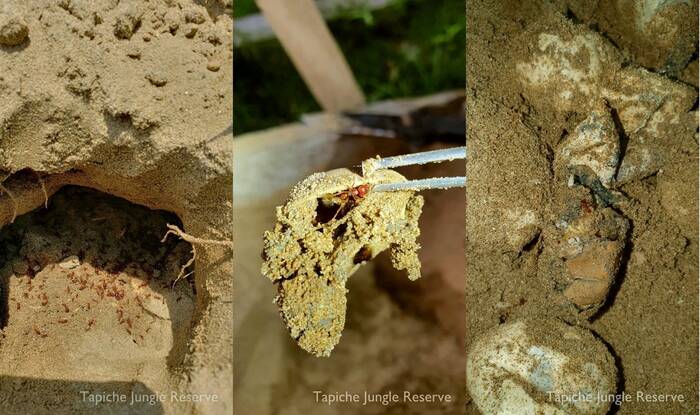 (Left) A partially excavated turtle nest being raided by Labidus coecus army ants. (Center) A turtle hatchling with most of the tissue removed from its body cavity; note the L. coecus worker clinging to the carapace. (Right) Damaged turtle eggs and a dead hatchling from a raided nest.
(Left) A partially excavated turtle nest being raided by Labidus coecus army ants. (Center) A turtle hatchling with most of the tissue removed from its body cavity; note the L. coecus worker clinging to the carapace. (Right) Damaged turtle eggs and a dead hatchling from a raided nest.
Paleotropical driver ants (genus Dorylus) regularly attack and consume vertebrates (Gotwald 1995), but it is often assumed that the blunt, non-crossing mandibles of Neotropical army ant workers preclude piercing of vertebrate skin and predation on vertebrates. Our paper adds to a growing literature suggesting vertebrates are on Latin American army ant menus more often than has been recognized (O’Donnell et al. 2005; Sazima 2017; López-Martínez et al. 2020). Relatively immobile vertebrates (including eggs and nestlings) may be especially vulnerable to Neotropical army ant predation. Larger-bodied L. coecus workers have impressive muscle-filled head capsules and large mandibles. Our observations suggested the ants entered turtle eggs and were also able to access hatchlings’ body cavities via soft tissues such as the eyes and yolk sacks. Army ant venom may also be relevant. Hatchlings that were stung by L. coecus workers appeared to be temporarily paralyzed, and some turtles died after being stung.
The L. coecus raid on riverside turtle nests raises interesting questions about access to the Tapiche beaches by mobile subterranean ant colonies. A small area around the lodge remains marginally above water (all of the soil is saturated) at the height of the flood season, but there are few other patches of land within several kilometers in all directions. There are two possibilities to explain a Labidus raid reaching the lodge beach: either these usually subterranean ants have some way of persisting in the area through the flood, perhaps by moving into trees or rotten logs above the water level, or the ants traveled several kilometers underground from the nearest dry land to reach the banks of the Tapiche River.
Army ant behavior present challenges for preventing predation on natural turtle nests and hatcheries. Army ant raids are massive and mobile, but some species such as L. coecus can raid continually for several days against rich food resources. Turtle nests in clusters on a beach or in a hatchery can suffer extensive damage from an army ant raid. Constructing hatcheries to prevent ant worker access from the soil beneath may discourage army ant predation, as long as abiotic conditions appropriate for turtle development can be maintained.
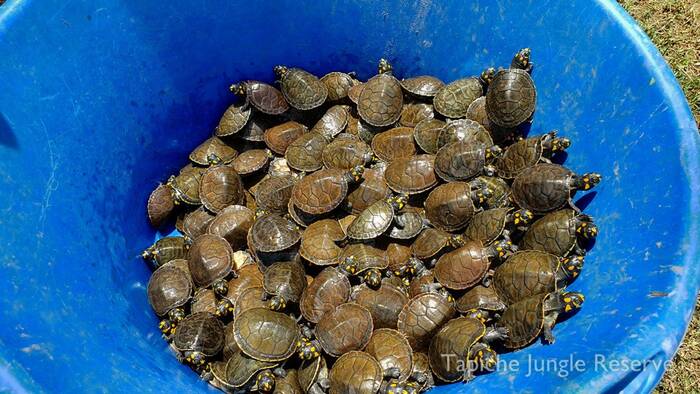 Amazon River Turtles that survived the L. coecus raid being prepared for release in a nearby oxbow lake.
Amazon River Turtles that survived the L. coecus raid being prepared for release in a nearby oxbow lake.
All photographs by Jana Reintjes
References
- Gotwald Jr, W.H. 1995. Army ants: the biology of social predation. Cornell University Press.
- López-Martínez GA, Rondón-Zabala JI, Martínez-Parales E, Moya-Arévalo RH, Rodríguez OA (2020) Depredacion por insectos de nidos y neonates protegidos de Podocnemis vogli (sabanas inundables del Casanare). Acta Biol Colom 25:354-358.
- O'Donnell, S., M. Kaspari, J. Lattke. 2005. Extraordinary predation by the Neotropical army ant Cheliomyrmex andicola: Implications for the evolution of the army ant syndrome. Biotropica 37: 706-709.
- Sazima I (2017) New World Army Ants Eciton burchellii kill and consume leaf-litter inhabiting lizards in the Atlantic Forest, Southeast Brazil. Trop Nat Hist 17:119-122.